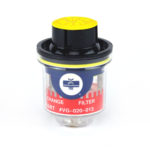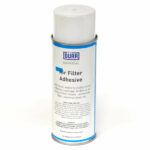Keeping your blower filter clean is an important part of ongoing blower maintenance. A brand new filter should have a pressure drop of between 2 to 3″ w.c. (water column). Once the pressure drop exceeds 10 to 15″ w.c., the filter should be replaced or changed.
Excessive pressure drop in your system costs you horsepower ($$$) and can also lead to equipment failure through excessive temperature rise on the blower, excessive horsepower absorbed by your drive (such as v-belts) leading to premature failure, and excessive horsepower on your motor causing overload and premature failure.
A simple differential pressure gauge can be screwed into the top of many filter housings. They visually indicate when the filter is in need of changing or replacement.
Most blower filter elements can be cleaned, prolonging their usable lifespan before they need to be replaced. Paper filter media is usually treated as disposable, but cleaning with compressed air can extend the lifespan quite a bit before it must be replaced. Felt, polyester, and polyurethane can all be washed and dried to extend their lifespan before they must be eventually replaced. Wire elements can be used indefinitely if they are washed and retreated. Cleaning instructions are provided below from several of the top blower filter manufacturers:
Cleaning Universal Filter Elements
Pleated Paper Air Filter Element
Because of the relatively low cost of the paper element, it is generally treated as disposable and replaced when dirty. However, the paper element can be cleaned and reused a number of times.
Water Cleaning: Rap gently to dislodge accumulated dirt, soak thoroughly approximately 15 minutes in warm water and mild detergent. Rinse thoroughly under low pressure water. Air dry – do not dry with compressed air.
Compressed Air cleaning: Carefully direct compressed air (100 psi maximum) through dry air filter element, opposite normal direction of flow. After cleaning, inspect carefully for holes or cracks. If damaged, replace element.
Pleated Felt Air Filter Element
Pleated felt elements may be cleaned and reused a number of times. Follow the cleaning instructions for paper elements.
Wire Mesh Air Filter Elements
For best efficiency, wire air filter elements must be treated when new and after each cleaning. For oil-free adhesive, spray the element on both sides with Universal Oil Free Adhesive (P/N 81-0323), following the directions on the container. For oil treatment, dip the element in SAE 30-50 motor oil and drain thoroughly before using.
To clean wire mesh element, wash in solvent or warm water and detergent in a container large enough for complete immersion of element. Rinse completely, drain either air dry or use compressed air. After cleaning and drying, re-treat the element with oil free adhesive or oil as described above.
Time to change your filter element? A clean element should have a pressure drop of 1 to 3″ of water column (w.c.). Filter elements should be changed when the pressure drop exceeds 10-15″w.c. of pressure loss. You may want to clean or replace the filter depending on the power usage of your machine. Remember, excessive pressure drop will cost you horsepower ($$$) and can also cause excessive temperature rise on the blower causing blower failure, excessive horsepower absorbed by your drive (for instance v-belts) which may cause premature failure, and excessive horsepower on your motor causing overload and premature failure
Cleaning Solberg Filter Elements
Solberg filter elements should be cleaned or replaced once the pressure drop reaches 10 to 15-inches water column (250 – 380mm WC) above the initial pressure drop of the installation. Please note that the overall performance of a filter element is altered once cleaned; the initial pressure drop after cleaning will be greater than the original, clean pressure drop of the element. After each subsequent cleaning, the initial pressure drop will continue to increase. Under all circumstances, the initial pressure drop of the element needs to be maintained at less than 15-inches water column (380mm WC). Cleaned elements that exceed 15-inches water column (380mm WC) at start-up should be replaced with new elements.
- Paper Element: The paper element may be lightly blown with low pressure air. It is disposable and in most cases should be replaced with a new element.
- Polyester Element: The polyester element may be washed in warm soapy water, vacuumed, gently blown out or replaced. Use a mild detergent like Dawn liquid soap. The element should be completely dry before reinstallation. The element should be replaced after a maximum of three cleanings.
- Polyurethane Prefilter: The prefilter may be washed as a sponge or replaced to give the element a longer service life.
- Epoxy Coated Wire Mesh and Stainless Steel Wire Mesh Elements: Cleaning instructions similar to polyester, except mild solvents may be used.
Cleaning your Stoddard Filter Element
Turn off the air moving device prior to servicing. Remove the wing nut on the housing cover and then lift the cover off. Check the filter elements and then service using the instructions below. After cleaning, check inside the housing for loose articles before replacing the weatherhood and restarting the air moving device.
To extend the service life of a Stoddard paper filter, rap the element to dislodge accumulated dirt. Alternately, compressed air (75 PSIG max) can be directed through the element opposite to the direction of air flow to dislodge dirt. These paper filter elements will eventually need to be replaced.
For the polyester felt elements or polyurethane prefilters, wash in sink or large pan using water and any good washday type detergent and rinse clean. Squeeze out filter by pressing it against metal grid. Let stand and allow to dry completely. Felt and polyurethane elements will eventually need to be replaced.
Epoxy coated wire mesh elements should be soaked in hot water and detergent. After the element has completely dried, adhestive (light oil) can be applied at 1.5 to 2 oz.; allow excess to drain off prior to installing. These elements can be used indefinitely.


